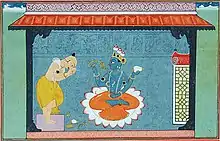Yadugiri Yathiraja Mutt
Yadugiri Yathiraja Mutt at Melkote is a Tenkalai Sri Vaishnava Mutt founded by Ramanujacharya for the management of Cheluvanarayana Swamy Temple and the propagation of Ramanuja Vishishtadvaita darshana. Yathiraja is also another name for Ramanuja.[1][2]
ಯದುಗಿರಿ ಯತಿರಾಜ ಮಠ | |
| Monastery information | |
|---|---|
| Order | Sri Vaishnava |
| Denomination | Tenkalai |
| Established | 12th Century |
| People | |
| Founder(s) | Ramanujacharya |
| Site | |
| Location | Melkote, Karnataka |
| Country | India |
| Coordinates | 12.661036°N 76.648546°E |
| Public access | Yes |
| Website | http://www.yathirajamutt.org/ |
| Part of a series on |
| Vaishnavism |
|---|
 |
| Part of a series on |
| Hinduism |
|---|
 |
Establishment
After Ramanujacharya was made the rajguru of Hoysala Empire, Lord Vishnu in a dream ordered Ramanuja to move to Melkote, where he would find the holy earth. Traditional accounts mention that the reason for travel was to search for namam clay for Srivaishnava Urdhva Pundra which was abundant in Melkote. Upon traveling, he found the holy earth and a vigraha of the god under an ant hill which was subsequently installed as the deity Tirunarayana of Melkote in the Bahudhanya year, Pushyamasa, Shukla Paksha, Chaturdashi according to Pancharatra agama. Ramanuja worshipped it for three days, followed by kumbhabhishekham and recited tamil vedas. Subsequently, the Yadugiri Yathiraja Mutt was established for a sanyasi to live and manage the affairs of the temple. The Jeeyars of the mutt attracted devotees and received royal patronage by their scholarship, devotion, and other qualities.[1] The mutt is entitled for a share in the properties, assets, funds, and services in the Cheluvanarayana Swamy Temple.[3] By 1256, Bhashyakara Sannidhi, a shrine for Ramanuja had been built and a Ramanuja Kutam, a choultry for feeding was provided a grant.[1][4]
Guruparamparai
Ramanuja created a temple manual Niyamanappadi for the systematic application of temple activities and left the administration to his fifty-two pratama sishyas with Tiruvali Annan of Sadamarshana gotra, Apastamba Dharmasutra, Yajurveda shakha carrying out the orders of Jeeyar.[1][5] In 1104, Ramanuja appointed Sri Deshantari Kelvi Tiru-Narayana Jeeyar as his successor at the mutt to propagate growth and was handed Cheluvanarayana Swamy Temple mudra.[6] With Ramanuja's motivating grace and as enshrined in the rule book Niyamanappadi, the Jeeyars continued the nitya bhagavat aradhana in & around the temple. The duties of the successor Jeeyars were to sign the papers relating to the temple treasury, look after the temple property, employ people for receiving all the income from the offerings, put his seal in addition to the royal seal and Ramanuja-mudre and receive the same honors that the fifty-two pratama sishyas were entitled to.[7] The current Jeeyar is Sri Yadugiri Yatiraja Narayana Ramanuja Jeeyar Swami.[8]
Later years
To this day, the mutt has had a long line of illustrious successors and the building is still intact.[9] In the eighteenth century, due to the Vadakalai and Tenkalai sectarian disputes in Tamilnadu and the litigation that followed, all the wealth of the mutt was diverted towards the dispute. The Yadugiri Yathiraja Matha at Melkote became a Tenkalai matha, with subsects of Purvasikha, the Kilnattars, and the Mandyans representing the matha. A dispute known as the Tirtha case arose between the Parakala Matha at Mysore and the Yadugiri Yathiraja Matha at Melkote on matters like the Mandayam entry and so on. The authorized representatives of Yadugiri Yathiraja Mutt observed that the Mandyam entry to the Yadugiri Yathiraja Mutt Gadi was from the year 1850 and that prior to that the line belonged to the Kilnattars and the present stone image of the sannyasin in the Yadugiri Yatiraja Math was the image of a purvasikhi, representative of the fifty-two followers of Ramanuja.[10]
References
- Jagannathan, Sarojini (1994). Impact of Śri Rāmānujāçarya on temple worship (1st ed.). Delhi: Nag Publishers. ISBN 8170812887.
In a dream, the Lord bade Ramanuja to move to Melkote, where he would find the holy earth. Accordingly, the next morning he found the holy earth and a vigraha of the Lord. In due course, he was installed Tirunarayana. In the Bahudhanya year, Pushyamasa Shukla Paksha, Chaturdashi, the deity was given a holy bath and worship. Once the deity was installed according to Pancharatra agama, Ramanuja himself worshipped it for three days, followed by samprokshanam and recited Oru Nayagam Tiruvaimoli, and subsequently, the Yati Raja math was established.
- The Brahmavâdin. M.C. Alasingaperumal. 1910.
- Melukote Through the Ages. Academy of Sanskrit Research. 1998.
- Pārttacārati, Intirā (2008). Ramanujar: The Life and Ideas of Ramanuja. Oxford University Press. ISBN 978-0-19-569161-0.
- Krishnamachari, Suganthy (5 January 2017). "Administration in the Melkote temple". The Hindu. Archived from the original on 26 May 2022. Retrieved 26 May 2022.
- Narasimhiengar, M. T.; F., J. F. (1915). "Ramanuja and Melukote". Journal of the Royal Asiatic Society of Great Britain and Ireland: 147–152. ISSN 0035-869X. JSTOR 25189291. Archived from the original on 2022-05-26. Retrieved 2022-05-26.
- Annual Report Of The Archaeological Survey Of Mysore For The Year 1904 To 1913.
- "Guruparamparai". www.yathirajamutt.org. Archived from the original on 2022-07-01. Retrieved 2022-05-23.
- Govindāchārya, Aḷkoṇḍavilli (1906). The Life of Râmânujâchârya: The Exponent of the Viśistâdvaita Philosophy. S. Murthy.
- Lakshamma, G. (1990). The impact of Rāmānuja's teaching on life and conditions in society. Delhi: Sundeep Prakashan. ISBN 9788185067469.